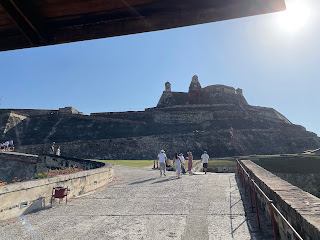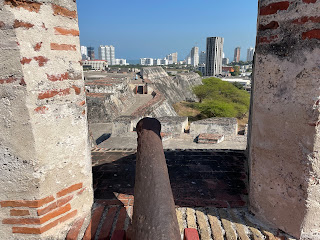This morning we met our local guide, Vicki, who is both knowledgeable and funny. She took us on a tour of San Felipe, the fortress built by the Spanish to guard the city of Cartagena.
Construction of the fortress began in 1536 and continued for more that 130 years. It was built, as Vicki said, so that the Spanish could keep people from stealing what they had stolen from other people. Much of the gold and other treasures of South America made its way here before being shipped off to Spain.
Most of the wall is reconstruction because, after the fortress was no longer of military value, local people queried stone from the walls to build homes and businesses. Sadly, this sort of thing is typical for antiquities all over the world. The thick walls were designed to repel cannonballs, and sloped in a way that would deflect them back toward attackers.
There are no living quarters in the fort. Soldiers lived in the walled city, and except for a small guard on watch, only came when summoned by the emergency bell. The defenses were state-of-the-art for their day.
The fort was only taken once, by the French in 1697. They only remained about a month, before the heat and diseases wiped out most of the invaders, allowing the Spanish to retake the fort once again.
Heat threatened to wipe us out, as well, as the bus brought us back into the walled city once again and Vicki took us on a walk to examine some of the colonial architecture.
There are still many big, old, Spanish houses here (like our hotel). They cost millions to buy, and even more to maintain in period style, as required by the government. Unique door knockers often symbolize how the home's original owner achieved their wealth.
Along the way, we encountered the usual "welcoming committee" of street vendors, who can be very persistent, but who are more polite than those in Egypt or some other countries. We also met some Palanqueras, the famous fruit basket ladies.
Originally, these women came from the town of San Basilio de Palenque, which was created in the mountains by the escaped slaves. They would come to Cartagena, carrying on their heads produce to sell in the city, wearing bright clothing to be visible, and singing the list of what they had for sale. They soon discovered they could make more money charging tourists for the privilege of taking their photo than they could make selling fruit.
Vicki also showed us the Dominican church and monastery, and discussed at length the role of the Spanish Inquisition in Colombia. The zealots pursued their cause in a particularly brutal manner here, primarily as a tool for stripping wealth from Jews, Protestants, or those insufficiently loyal to the Catholic hierarchy.
We also got a glimpse of the Cathedral and a house where Sir Francis Drake once lived while passing through Cartagena (Drake also once tried to plunder the city with the help of buccaneers he had recruited as British mercenaries).
Hot from walking in the sun, we returned to the bus for a visit to an "Emerald Museum." Colombia is known for producing emeralds, and there are jewelry shops all over Cartagena. Supposedly, this "museum" houses a program to train underprivileged teens as jewelers.
We got a tour, with lengthy explanation of emerald mining and jewelry making, but we saw no teens. There was, however, a large sales floor with a lot of "assistants" ready to sell us jewelry.
Mary and I were having none of that, so we walked a couple blocks down to the beach to see what was going on there. There were folks who wanted desperately to rent us umbrellas or chairs, and even more who wanted to sell us cold water, Coke, or beer. And there was at least one woman sunning herself without the aid of her bikini top. Otherwise, it was just a nice, sandy beach.
Finally, the jewelry buyers were finished and we got on the bus to go to lunch. It was a seafood place popular with locals. Even though we had ordered ahead, service was slow. But the food was OK and the ice cream dessert was really good.
The group returned to the hotel. But in need of a haircut, I set out to find the barbershop we had passed the previous evening. Mary accompanied me. My Spanish was almost good enough, but broke down a bit in the bargaining process. With a little help from Google Translate, the price came down from 50,000 Pesos to 30,000 Pesos (about $6.50 U.S.)
Then I had to describe, in what little Spanish I have, how I wanted my hair to be cut. I must have done OK, because it's the best haircut I've had in quite a while. He took his time and was very careful, even if I was a little nervous when he trimmed my neck and around my ears with a straight razor.
In the evening, we joined some other members of our group for drinks at an outdoor restaurant in the square, just half a block from our hotel. It's a loud and boisterous place! Lots of activity, lots of night life on the streets. Great people-watching.

















No comments:
Post a Comment